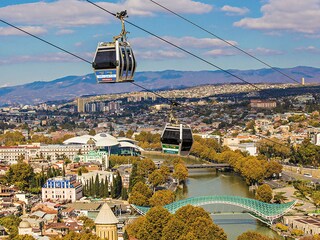Travel: 36 hours in Tbilisi
Time is no constraint in experiencing a slice of life—past and present —of this Eurasian city


Noon: Go on a walking tour The best way to get your bearings in a new city is to walk down its broad roads and narrow streets, spot popular landmarks and discover hidden corners. Better still, book yourself a walking tour and let experts guide you. Choose from exploring street art to unearthing secrets from the Soviet era. Meander through a vibrant market or go on a pub crawl. The options are endless and varied to different tastes.
Local guides will regale you with many stories, including how Christianity came to Georgia and why the tamada or toastmaster is the most important part of a local feast. Follow your nose and your guide down into the basement of a 15th-century bakery and try some freshly baked shoti or Georgian bread. Baked in a wood fired oven similar to a tandoor, Georgians throng their neighbourhood bakeries all day long for fresh, hot bread.
Even if those feet ache, don’t stop just yet. Walk further to discover a waterfall right in the middle of the city that’s well shielded from the tourist eye, tucked behind the brick domes of the bath houses of Abanotubani.
In the park below, families with children flock to the gardens and open play areas, while couples seek quiet corners and the elderly take to the benches. Amble down the well-tended pathways to another of Tbilisi’s avant-garde additions: The twin tubular buildings that house a concert hall and exhibition centre. Exit the park and take the aerial tramway up to the Narikala Fortress in time to watch the sunset.
With tables tucked into quiet corners of a sprawling garden of the Georgian Writers’ Union building is Cafe Littera, centred around an enormous pine tree. Chef Tekuna Gachechiladze’s twist on traditional Georgian fare compliments the unusual setting of the restaurant. A big draw is her chakapuli, a sour plum and tarragon flavoured stew.
Slow, long meals are the norm in Georgia, and Cafe Littera despite its popularity is in no hurry to have a high turnover of its tables. And although the menu frequently changes, featuring a variety of seasonal produce, what remains constant is a wide selection of good Georgian wine.
The building also houses the Museum of Soviet Occupation and the exhibits offers a detailed insight into life in the country under Soviet rule.
1 pm: Go souvenir hunting Dry Bridge Market, as the name suggests, is located on a dry river bed and is the perfect place to find souvenirs. There’s a wide variety on offer from paintings, handicrafts and carpets to Soviet memorabilia, the latter being the biggest draw. After the fall of the Soviet Union, such markets popped up around the country, giving the locals a chance to make additional income by selling their possessions. Rare coins, used metal bottles, lunchboxes, vintage maps, radios, medals and even gas masks are up for sale. Go with time on your hands, as well as cash since credit cards are not accepted. Most of the vendors are very friendly and let you browse through their wares even if you aren’t looking to buy.
7 pm: Load up on Georgian classicsA hidden gem, Salobie Bia serves some of the finest Georgian food in an unassuming, cheerful setting. Handwritten menus, simple wooden furniture and local art take centre stage in this restaurant run by a husband and wife duo.
The menu, while limited, features many Georgian classics including local beer, wine and in-house brewed chacha, a local pomace brandy. A must try is their lobio or kidney bean stew served in a ceramic pot with a side of pickled vegetables and mchadi or corn bread.
First Published: Nov 16, 2019, 07:16
Subscribe Now